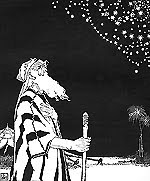In Kabbalah, the Sephirot are the ten attributes or emanations through which God created the world and/or manifests.
The Tree of Life, or Etz haChayim (עץ החיים) in Hebrew, is a mystical symbol used in the Kabbalah of esoteric Judaism to describe the path to God and the manner in which he created the world ex nihilo, out of nothing. The Kabbalists developed this concept into a full model of reality, using the tree to depict a map of Creation. The Tree of Life presents ten sephirot. It may correspond to the Tree of Life mentioned in Genesis 2:9.

Portae Lucis: The Wise Man holding the Tree of Life, engraving, Augsburg 1516
Joseph ben Abraham Gikatilla (1248–1305) (Hebrew: יוסף בן אברהם ג'יקטיליה, Spanish: Chiquitilla, "The Little One") was a Spanish kabbalist, student of Abraham Abulafia. Born at Medinaceli, Old Castile, Gikatilla was for some time a pupil of the kabbalist Abraham Abulafia, by whom he is highly praised; his kabbalistic knowledge became so profound that he was supposed to be able to work miracles, and on this account was called "Joseph Ba'al ha-Nissim" (the Thaumaturge or literally Master of Miracles; Zacuto, Yuḥasin, p. 224a). Like his master, Gikatilla occupied himself with mystic combinations and transpositions of letters and numbers; indeed, Abulafia considered him as the continuator of his school (Adolf Jellinek, B.H. iii, p. xl). But Gikatilla was not an adversary of philosophy; on the contrary, he tried to reconcile philosophy with kabbalah, declaring that the latter is the foundation of the former. He, however, strove after the higher science, that is, mysticism. His works in general represent a progressive development of philosophical insight into mysticism. His first work shows that he had considerable knowledge of secular sciences, and that he was familiar with the works of Ibn Gabirol, Ibn Ezra, Maimonides, and others. He died at Peñafiel after 1305.
See also:
Kabbalah
Tree of Life
Klippot





